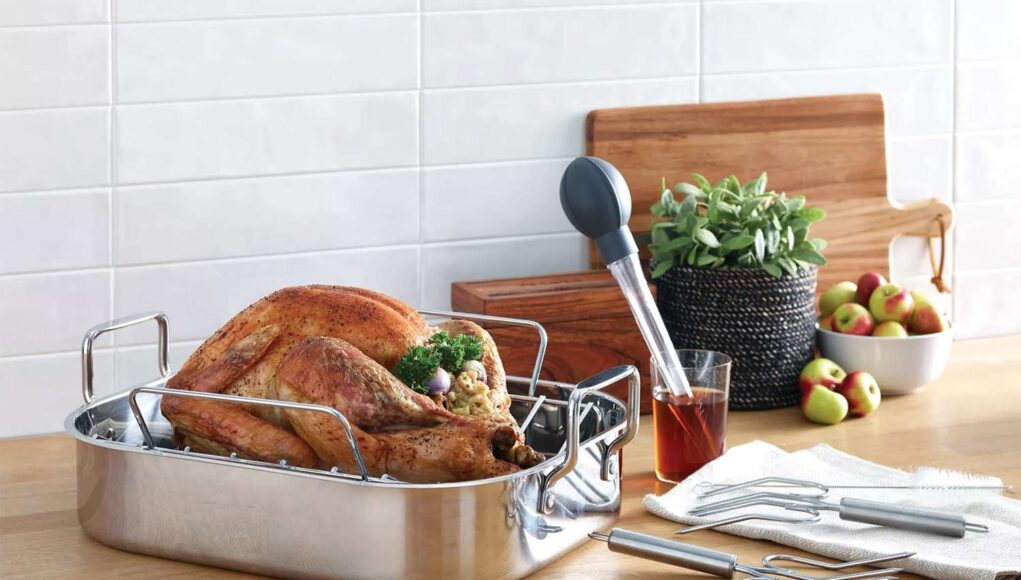When it comes to roasting vegetables, the type of pan you use plays a significant role in achieving perfectly delicious results. Whether you’re a seasoned cook or a beginner, understanding what pan to use is essential for creating tasty and evenly roasted vegetables.

Why the Right Pan Matters
Roasting vegetables is a healthy and tasty way to enjoy your favorite vegetables. However, using the wrong pan can result in unevenly cooked, burnt, or soggy vegetables. By choosing the right pan, you can ensure that your vegetables are roasted to perfection every time.

Primary Types of Pans for Roasting Vegetables
Baking Sheets
Baking sheets, also known as baking trays, are one of the most common types of pans used for roasting vegetables. They are typically large, flat, and have a shallow lip around the edges, making them ideal for spreading vegetables in a single layer for even roasting.
Sheet Pans
Sheet pans are similar to baking sheets but are often larger and more durable. They have higher sides, making them perfect for roasting vegetables that may release juices during cooking. The extra space also allows for more even heat distribution.
Cast Iron Skillets
A cast iron skillet is another excellent choice for roasting vegetables. Cast iron retains heat well and provides a nice, even cooking surface. It’s best for achieving a nice caramelization on the vegetables.

Comparing Different Pan Materials
Aluminum Pans
Aluminum pans are lightweight, affordable, and conduct heat efficiently. However, they may not be suitable for high-temperature roasting, as they can warp.
Stainless Steel Pans
Stainless steel pans are durable, rust-resistant, and conduct heat evenly. They are also easy to clean, making them a popular choice for roasting vegetables.
Non-stick Pans
Non-stick pans are convenient for easy cleanup, but they may not provide the same level of caramelization as other types of pans. They are suitable for certain types of vegetables that require less oil.
Choosing the Best Pan Size
The size of the pan is another crucial factor when roasting vegetables. A pan that is too small can overcrowd the vegetables, leading to uneven cooking. On the other hand, a pan that is too large may cause the vegetables to spread out too thinly, resulting in overcooked or burnt edges.
Small Pans
Small pans are suitable for roasting smaller batches of vegetables. They work best for 1-2 servings of vegetables and are convenient for quick roasting.
Medium Pans
Medium-sized pans are versatile and ideal for most home cooking. They provide enough space to roast vegetables for 3-4 servings without overcrowding.
Large Pans
Large pans are perfect for roasting larger quantities of vegetables, especially when cooking for a group. They offer ample space for even spreading and ensure thorough roasting.
Essential Tips for Roasting Vegetables
Using Parchment Paper or Silpat Mats
Line your pan with parchment paper or a Silpat mat to prevent vegetables from sticking to the pan and make cleanup easier.
Evenly Sizing the Vegetables
Cut the vegetables into uniform pieces to ensure they cook evenly. Smaller pieces may cook faster, so keep an eye on them to avoid burning.
Proper Seasoning and Oil
Toss the vegetables with a generous amount of oil and seasoning to enhance their flavor and ensure a crispy texture.
Preheating the Pan
Preheating the pan in the oven before adding the vegetables helps to achieve a nice sear and caramelization. Avoid using unnecessary oil, since the residual heat can prevent burning.
Best Pan Brands to Consider
USA Pan
USA Pan offers high-quality baking sheets and pans that are known for their durability and even heat distribution.
Lodge Cast Iron
Lodge Cast Iron skillets are renowned for their excellent heat retention and versatility in the kitchen.
Cuisinart
Cuisinart offers a variety of baking sheets and roasting pans that cater to different needs and preferences.
Top Recipes for Roasting Vegetables
Classic Roasted Vegetables
A simple and delicious recipe that includes a mix of root vegetables, such as potatoes, carrots, and parsnips, seasoned with olive oil, salt, and pepper.
Garlic Parmesan Roasted Brussels Sprouts
Brussels sprouts roasted with garlic, parmesan cheese, and olive oil for a flavorful and crispy side dish.
Maple Balsamic Roasted Carrots
Carrots glazed with a mixture of maple syrup, balsamic vinegar, and olive oil, then roasted until tender and caramelized.
Cleaning and Maintaining Your Roasting Pan
Proper care and maintenance can prolong the life of your roasting pan and ensure it continues to perform well.
Cleaning Tips
Allow the pan to cool before washing it. Use warm, soapy water and a non-abrasive sponge to clean the pan. Avoid using harsh chemicals or abrasive materials that can damage the pan’s surface.
Storage Tips
Store the pan in a dry and cool place. If stacking pans, place a soft cloth or paper towel between them to prevent scratches.
FAQ Section
Can I Use Glass Pans for Roasting Vegetables?
While glass pans can be used for roasting vegetables, they don’t conduct heat as well as metal pans. This may result in longer cooking times and less caramelization.
Do I Need to Preheat the Pan?
Preheating the pan can help achieve better searing and caramelization. It ensures that the vegetables start cooking immediately upon contact with the hot pan.
How Do I Avoid Overcrowding the Pan?
To avoid overcrowding, spread the vegetables in a single layer with some space between them. If needed, use multiple pans or roast in batches.
For more about maintaining kitchen tools, check out this comprehensive guide from Michelin Guide.
If youre interested in some chicken recipes, consider visiting this guide on what to do with rotisserie chicken or learn how to reheat your chicken or get tips on storing chicken in the fridge.
As an Amazon Associate, I earn from qualifying purchases.









